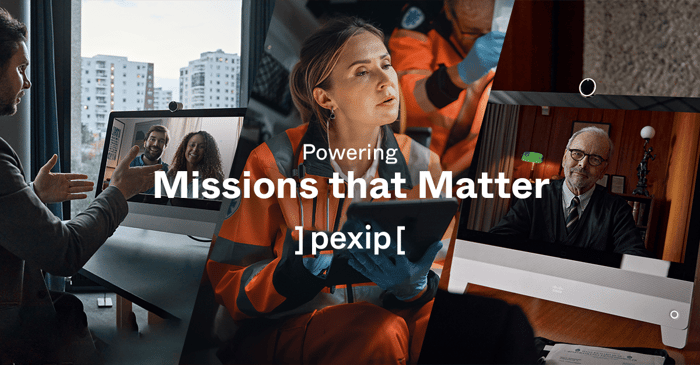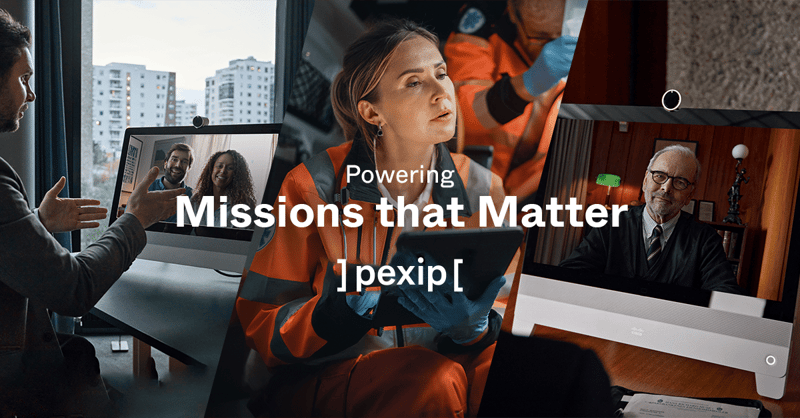The world has changed, and so must Pexip. Successful organizations must challenge their business model continuously and explore new growth engines, says CMO, Patricia Auseth.
While none of us anticipated a global pandemic, it rang loudly and transformed whole industries when it happened. Video communication was one of those industries.
10 years ago, communications took place in person, via email, or through audio conferencing. Pexip was founded based on the potential for video communications in meetings everywhere and anywhere. Today, video communication is how work is done and has become an essential business function. For Gen Z in the workplace, video IS the new voice.
The world has changed, and so must Pexip. Successful organizations must challenge their business model continuously and explore new growth engines.
Digital transformation and business reinvention
 We're in good company. I recently listened to a fascinating podcast series hosted by the head of the Norwegian Oil Fund, Nicolai Tangen. His interview with BP CEO Bernard Looney stood out in particular.
We're in good company. I recently listened to a fascinating podcast series hosted by the head of the Norwegian Oil Fund, Nicolai Tangen. His interview with BP CEO Bernard Looney stood out in particular.
During the pandemic, when faced with a period of flat growth due to restrictions, BP undertook the largest restructure in its 112-year history. Their historic model had been profitable, but to keep up with rapidly evolving customer demands and societal expectations, they had to focus on new ways of working.
Looney recognized that they needed to build a future company based on low carbon energy, not only rely on energy models of the past. Their traditional markets supported their new strategy, as they reduced the volume of hydrocarbons produced – oil, gas, fossil fuels – while reinvesting profits into growth engines and other more sustainable energies such as biochemicals, EV technology, and hydrogen.
Alexander Osterwalder, business theorist and author on the importance of business reinvention, also highlights the strategic and cultural shifts Microsoft had to go through to accelerate to a new level in his book, Invincible Company.
When Satya Nadella became CEO in 2014, despite years of rallying against open-source, he led the company away from a proprietary Windows software approach. It was an important move for the company as it increased revenue opportunities from consumers using competitor eco-systems. That, combined with its pivot to the cloud, means that Microsoft is again one of the most successful companies in the world.
From meetings to missions
For Pexip, we are moving from meetings to missions. Our foundation has been to securely connect people in meetings regardless of technology, allowing users to standardize on their meeting tool of choice. Moving forward, we are embedding video into any business process, allowing organizations to accelerate their digitization roadmap. For some industries, this is absolutely essential.
During the pandemic, businesses transferred their communications onto video, operationalizing a hybrid working environment. For many, the distributed enterprise has become the norm, and most organizations connect employees and customers virtually to allow for employee flexibility and customer reach and satisfaction. Other industries – healthcare, judicial, and government – did the same, completely revolutionizing infrastructure, operational processes, and policies to deliver essential, mission-critical services. They now place video at the core of their operation, completely digitizing specific processes and workflows.
Healthcare workers can facilitate end-of-life communications in ICU wards when families and loved ones cannot visit those closest to them who are seriously ill. Doctors continued to see patients using virtual healthcare. Senior care communities adapted, enabling people most at risk to see their families over video. Hospitals are placing videos in ambulances allowing paramedics to provide the proper care at the right time, which is critical in situations where every second counts.
Courtrooms, tribunals, and justice systems worldwide quickly found video solutions to enable justice and increase advocacy through virtual courtrooms. Today, Pexip provides complete digital courtroom experiences.
And governments that needed to deliver essential services – job and social security support – found new ways of connecting with citizens.
Video became integrated into operational workflows and developed to deliver increasingly sophisticated services – to consumers and citizens. And while the adoption of video was initially driven by necessity, organizations continue to recognize the value that video communications provide and its potential for the future.
The future of video: powering missions that matter
"The future belongs to those who can hear it coming." - David Bowie
At Pexip, we have a fantastic video technology platform that is not only limited to meetings. That's why we're broadening our focus from meetings… to missions.
Businesses and organizations will continue to use video to conduct their day-to-day meetings. While – in most countries – restrictions have mostly been lifted, individuals and organizations continue to use video conferencing regularly.
But for the next stage in Pexip's journey, we will broaden our focus, working with industries such as healthcare, judicial, government, finance, and retail to reimagine how they deliver future services to consumers and citizens using video.
Whether increasing advocacy for those in the justice system, widening public access to virtual hearings, offering greater access to financial services via customer-centric experiences, or bringing patients together with healthcare providers, clinicians, and loved ones, our focus is on transforming the way people, technology and services connect.
Our move to missions starts by understanding our customers more closely than ever before. It will focus on learning more about their problems, their values, their aims, and finding the solution. It requires us to be courageous, different, and better.
We've heard the future is coming, and it's time to innovate.
- Healthcare
- Judicial
- Government
- Digital transformation






